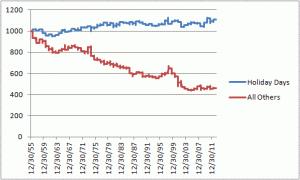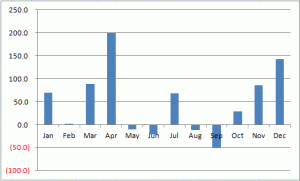Oh, it’s a long, long while from May to December
But the days grow short when you reach September.
September Song
T.S. Eliot was wrong about April being the cruelest month. For investment managers, it’s September.
It’s bad enough that September marks the end of summer, shorter days, cooler weather, the beginning of school and the almost annual Red Sox meltdown. It’s also the worst month, by far, for stock market performance.
Since 1955, the Dow Jones Industrials Average (DJIA) cumulatively has lost just under 50% during September, according to “Jay on the Markets.” In contrast, the DJIA has gained 200% in April over the same period. So, in spite of Mr. Eliot’s claims, April is the kindest month, not the cruelest.
May (-10.6%), June (-20.9%) and August (-11.6%) have also registered net losses over that period, as the chart shows, but September losses (-49.1%) total more than those three market-declining months added together. In other words, September is a big loser. Take September out of the calendar and the market would historically be flying high.
Read On, Before You Sell
So should you sell all of your stock holdings on August 30, the last trading day before September?
Before you do, keep in mind that “past performance is no guarantee of future performance,” like those folks in compliance like us to say. That holds whether past performance was good or bad. Note, too, that the DJIA has had a positive performance in six of the past eight years during September, gaining at least +2.3% or more on five of those years.
On the other hand, that 49.1% loss has happened in spite of those recent positive September performances. In addition, it is widely believed that the Federal Reserve Board will begin “tapering” bond purchases in September.
The hint in May that tapering was beginning soon caused the market to drop. What will happen when tapering actually begins?
Consider Your Options
While September is just over a week away, you may take a little more time before taking action.
As “Jay on the Markets” notes, the market typically performs well three days before and three days after market holidays. Consider, in the chart below, what would have happened to $1,000 invested in the DJIA during the pre- and post-Labor Day period, compared with all other trading days in September. 
Cumulatively, since 1955, the trading days before and after Labor Day showed a gain of +10.6%, while all other trading days in September showed a cumulative loss of -54%.
In spite of September’s dangers, you may decide to keep your investments where they are and hope for the best. After all, there are 12 months to the year. Conversely, you may decide to sell some of your stock and repurchase shares in October.
If you want to potentially take advantage of the market, you can sell covered calls to generate income in case your stocks move sideways or lower. You can also put money into an inverse stock index fund, so when the market declines, the price of your fund will rise. However, keep in mind that if you take either of these approaches and the market rises, you will lose money.
September is the cruelest month. But once it begins, October is just 30 days away.

